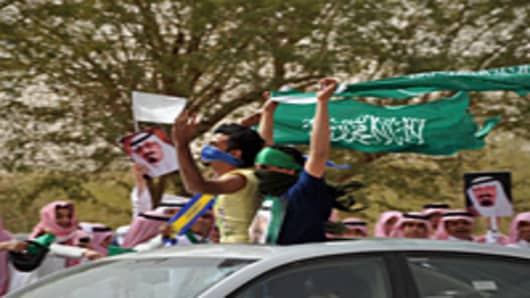Saudi Arabian policymakers will keep a careful eye on inflation in the coming months, following two massive infusions of stimulus money that they hope will support the Arab world's largest economy without driving domestic prices much higher.
In a bid to stave off any chance of domestic unrest—and in an overt display of wealth—Saudi Arabia recently passed a $93.3 billion financial support package. That's on top of $36 billion announced on February 23—a total that equates to almost 30 percent of gross domestic product. With oil prices as high as they are, the Kingdom can, for the moment at least, afford it.
Annual inflation slowed to a 10-month low of 4.9 percent in February compared with 5.3 percent a month earlier, but the effect of this new stimulus has yet to be reflected. And nobody seems to be entirely certain as to how it will play out.
In its latest report, Banque Saudi Fransi cited broad money supply growth (M3) as accelerating to 8.6 percent in February, the fastest year-on-year growth since 2009. While still off the double-digit levels of 2008, if this trajectory holds it could "lend impetus to inflation".
The country's finance minister, Ibrahim Al-Assaf, admitted on March 26 that inflation could be driven higher by the new financial support packages, but hoped that if there was any impact it would be "temporary and limited".
Mario Maratheftis, head of Research West, at Standard Chartered, agrees. But given that the majority of spending will go into housing, specifically "the construction of new properties," the increased housing supply "could end up reducing inflation pressures," Maratheftis said.
A Reuters poll average of inflation expectations came in at 5.6 percent for 2011, up from 5.3 percent a year before.
Revaluation Ahead?
From the point of view of a central bank that is playing within the confines of a peg, there are still many ways you could deal with rising prices.
An often cited option is revaluation; another could be a move away from the dollar peg entirely and adopting a new exchange rate mechanism. The Saudi Riyal has been pegged to the greenback at 3.75 since 1986.
It wouldn't be the first de-peg in the petrodollar economies of the Gulf. In 2007, Kuwait surprised many when it announced that it was ending the peg of its Kuwaiti Dinar to the US dollar, deciding to opt for a basket of currencies instead.
"Gains from revaluation are doubtful" Mohamed Al-Jasser, the Governor of the Saudi Monetary Agency (SAMA), wrote in the Financial Stability Review (FSR) earlier this year.
The country's loyalty to the peg, for economic reasons spanning from the nature of the international oil market to investor confidence, is well known. But the volatility of oil prices as of late is likely to keep the government nervous.
Keeping in mind the landmark spending commitments, Banque Saudi Fransi underscores that "medium-term fiscal risks loom if extra outlays are added and restraint is not exercised". Moreover, the Institute of International Finance(IIF) estimates that Saudi Arabia may need an oil price of $110 per barrel by 2015 to balance its budget.
Back in July of 2008, with inflation at 30-year highs of just over 11 percent, an internal committee of the influential Shura Council that advises Saudi King Abdullah urged a revaluation of the riyal to help reduce the cost of imports.
Challenging Situation
A weak dollar makes the situation more challenging, but Riyadh-based Jadwa Investments does "not foresee exchange rate moves adding to imported inflation" in Saudi Arabia and "unlike on previous occasions the rising oil price is not being accompanied by a period of dollar weakness". But we know how quickly that can turn around.
The peg limits the ability of authorities to consistently adopt appropriate interest rate strategies in response to rising prices.
When the US Federal Reserve cut interest rates in September 2007, Saudi Arabia was in need of a tighter monetary policy and SAMA, the country's central bank, decided not to follow immediately.
Interpreting that as a possible signal for an imminent de-peg, it kicked off a bout of speculative buying of the Saudi riyal.
Not at the moment though, Maratheftis, who does not believe it's a trade investors are looking at just yet, said. The uncertain geopolitical outlook is of course one reason. He explained that the forward market for the Saudi Riyal shows "that there is currently no pressure whatsoever on the currency for a revaluation".
A historical anecdote perhaps: Veteran commodities trader Michael Marcus was quoted as telling author Sebastian Mallaby that he took "huge positions" in the Saudi riyal, even "leveraging himself up with borrowed money," since "devaluation was inconceivable" at the time.
In March of 1975, with oil prices having risen dramatically and inflation hovering around 30 percent, Saudi Arabia abandoned its dollar link and revalued.


